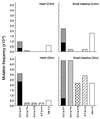Distinct spectra of somatic mutations accumulated with age in mouse heart and small intestine
- PMID: 10900004
- PMCID: PMC26960
- DOI: 10.1073/pnas.97.15.8403
Distinct spectra of somatic mutations accumulated with age in mouse heart and small intestine
Abstract
Somatic mutation accumulation has been implicated as a major cause of cancer and aging. By using a transgenic mouse model with a chromosomally integrated lacZ reporter gene, mutational spectra were characterized at young and old age in two organs greatly differing in proliferative activity, i.e., the heart and small intestine. At young age the spectra were nearly identical, mainly consisting of G. C to A.T transitions and 1-bp deletions. At old age, however, distinct patterns of mutations had developed. In small intestine, only point mutations were found to accumulate, including G.C to T.A, G.C to C.G, and A.T to C.G transversions and G.C to A.T transitions. In contrast, in heart about half of the accumulated mutations appeared to be large genome rearrangements, involving up to 34 centimorgans of chromosomal DNA. Virtually all other mutations accumulating in the heart appeared to be G.C to A.T transitions at CpG sites. These results suggest that distinct mechanisms lead to organ-specific genome deterioration and dysfunction at old age.
Figures




References
-
- Yu C E, Oshima J, Fu Y H, Wijsman E M, Hisama F, Alisch R, Matthews S, Nakura J, Miki T, Ouais S, et al. Science. 1996;272:258–262. - PubMed
-
- Shen J C, Gray M D, Oshima J, Kamath-Loeb A S, Fry M, Loeb L A. J Biol Chem. 1998;273:34139–34144. - PubMed
-
- Turker M S, Martin G M. In: Principles of Geriatric Medicine and Gerontology. 4th Ed. Hazzard W R, Blass J P, Ettinger W H Jr, Halter J B, Ouslander J G, editors. New York: McGraw–Hill; 1999. pp. 21–44.
Publication types
MeSH terms
LinkOut - more resources
Full Text Sources
Medical
Molecular Biology Databases

